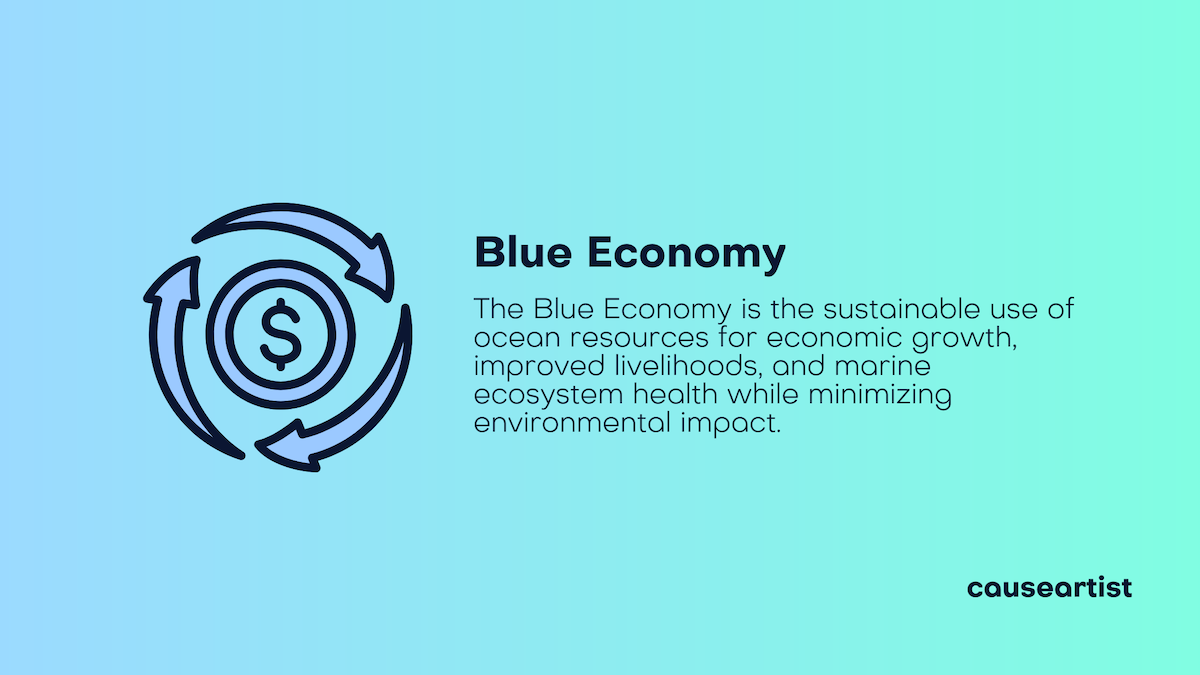The Blue Economy is a concept that has gained significant attention in recent years as nations and industries recognize the immense potential of the ocean while striving for sustainability.
It refers to the sustainable use of ocean resources for economic growth, improved livelihoods, and environmental health.
With over 70% of the Earth's surface covered by oceans, the Blue Economy encompasses various industries, including fisheries, offshore energy, maritime transport, coastal tourism, and marine biotechnology.
However, unlike traditional marine industries, the Blue Economy prioritizes long-term sustainability, balancing economic development with environmental conservation.
This blog post explores the concept of the Blue Economy, its key sectors, benefits, challenges, and its role in combating climate instability and ensuring a sustainable future for our oceans.
Understanding the Blue Economy
The term "Blue Economy" was first introduced at the Rio+20 United Nations Conference on Sustainable Development in 2012.
It builds on the principles of the Green Economy, which aims to promote sustainability while fostering economic growth.
At its core, the Blue Economy seeks to:
✔ Enhance economic opportunities derived from ocean resources.
✔ Preserve marine ecosystems by minimizing environmental impact.
✔ Support coastal communities that depend on marine industries.
✔ Promote innovation in sustainable maritime practices.
According to the World Bank, the Blue Economy consists of activities that:
- Provide economic benefits while ensuring the long-term health of ocean ecosystems.
- Support social inclusion and job creation in marine industries.
- Reduce the carbon footprint of ocean-based industries.
With global ocean-based economic activities valued at over $1.5 trillion annually, the Blue Economy has become a crucial driver of sustainable development goals (SDGs) worldwide.

Key Sectors of the Blue Economy
The Blue Economy is made up of various sectors, each contributing to economic growth while focusing on sustainability. Here are some of the most important ones:
1. Fisheries and Aquaculture
✔ Sustainable Fishing: The Blue Economy promotes responsible fishing practices that prevent overfishing, protect biodiversity, and maintain fish populations.
✔ Aquaculture (Fish Farming): The controlled farming of fish, shellfish, and seaweed provides a sustainable alternative to wild fishing, reducing pressure on marine ecosystems.
2. Offshore Renewable Energy
✔ Offshore Wind Farms: Harnessing wind energy from offshore turbines helps reduce reliance on fossil fuels.
✔ Wave and Tidal Energy: Innovative technologies are emerging to generate electricity from ocean waves and tides, contributing to clean energy goals.
3. Sustainable Tourism and Coastal Development
✔ Eco-Tourism: Sustainable tourism focuses on minimizing environmental impact while promoting marine conservation and community engagement.
✔ Coastal Protection: The Blue Economy supports policies that protect coral reefs, mangroves, and other natural barriers to climate change effects.
4. Maritime Transport and Shipping
✔ Green Shipping: The shipping industry is a major contributor to greenhouse gas emissions. The Blue Economy advocates for low-carbon and energy-efficient shipping solutions.
✔ Decarbonization of Ports: Efforts are being made to develop sustainable port operations that reduce pollution and carbon emissions.
5. Marine Biotechnology and Ocean-Based Products
✔ Marine Pharmaceuticals: Many new medicines are derived from marine organisms, offering potential breakthroughs in healthcare.
✔ Bioplastics and Sustainable Materials: Ocean resources are being explored for creating biodegradable plastics and sustainable materials to combat plastic pollution.
6. Carbon Sequestration and Ocean Conservation
✔ Blue Carbon Ecosystems: Mangroves, seagrasses, and salt marshes absorb and store large amounts of CO₂, playing a crucial role in climate change mitigation.
✔ Marine Protected Areas (MPAs): Expanding ocean conservation zones helps protect marine biodiversity and sustain fish populations.
Why the Blue Economy Matters
The Blue Economy is not just about economic growth—it is a necessary framework for balancing economic activity with ocean conservation. Here’s why it matters:
1. Climate Change Mitigation
Oceans absorb about 30% of global CO₂ emissions, making them vital in fighting climate change. Sustainable ocean management can help reduce ocean acidification, protect marine life, and maintain global temperature stability.
2. Job Creation and Economic Growth
The ocean economy supports over 3 billion people worldwide, especially in coastal communities. Sustainable marine industries can create millions of new jobs while ensuring long-term economic resilience.
3. Food Security and Sustainable Fisheries
With the global population expected to reach 10 billion by 2050, sustainable fisheries and aquaculture will be critical for food security. The Blue Economy ensures that fish stocks remain healthy for future generations.
4. Marine Ecosystem Protection
Unregulated industrial activities have led to severe ocean degradation. By promoting marine conservation efforts, the Blue Economy helps restore damaged ecosystems, benefiting both wildlife and human communities.
5. Innovation in Ocean-Based Solutions
From biodegradable plastics to offshore renewable energy, the Blue Economy fosters innovation that can reduce pollution, combat climate change, and drive technological progress.
Challenges Facing the Blue Economy
Despite its many benefits, the Blue Economy faces several challenges that must be addressed for it to be fully sustainable:
1. Overfishing and Illegal Fishing
- Overfishing threatens marine biodiversity and disrupts the ocean food chain.
- Solution: Stricter regulations and monitoring of fishing activities.
2. Marine Pollution and Plastic Waste
- 8 million tons of plastic enter the ocean every year, harming marine life and ecosystems.
- Solution: Developing circular economies, reducing single-use plastics, and investing in ocean cleanup technologies.
3. Climate Change and Rising Sea Levels
- Warming oceans and rising sea levels threaten coastal cities and marine ecosystems.
- Solution: Strengthening coastal defenses and investing in climate adaptation strategies.
4. Sustainable Investment and Funding
- Many ocean-based industries still rely on fossil fuels.
- Solution: Governments and private sectors must invest in sustainable marine projects and technologies.
The Future of the Blue Economy
The Blue Economy represents one of the greatest opportunities for sustainable economic growth in the coming decades.
Governments, businesses, and environmental organizations must work together to develop policies and technologies that:
✔ Promote responsible ocean management
✔ Encourage innovation in sustainable industries
✔ Protect marine biodiversity
✔ Ensure economic opportunities for coastal communities
With the right strategies, the Blue Economy can help us achieve a healthy ocean, a thriving economy, and a sustainable future for all.







